ABSTRACT
The Poohkay (GlQl-3) artifacts, from a site situated near the forks of the Peace and Smoky Rivers of northwestern Alberta, reflect a lost tool kit or possible offering deposited on unusual terrain on the floor of former Glacial Lake Peace. The GlQl-3 points and preforms cannot currently be dated but share strong metric and morphological similarities with Haskett and Hell Gap points, although one specimen is indistinguishable from Sluiceway materials typical of North Slope Alaska. As with other indications, this assemblage affirms that the Peace River Country served as a point of contact between eastern Beringian and southern worlds prior to biogeographic “closing” of the deglaciating Ice-Free Corridor.
1. Introduction
Apart from recent interest in its status as a “bottleneck” in the deglaciating Ice-Free Corridor, the Peace River Country of northwestern Alberta and northeastern British Columbia has attracted comparatively little archaeological research attention. Terminal Pleistocene and early Holocene artifacts are nonetheless abundantly represented in avocational, local, and regional museum collections that accrued because of the extensive agriculture in the region. Several factors indicate that the entire Corridor, including the Peace Country, supported large mammal populations and even some wooded vegetation by ∼13,200 calendar years ago (cal yr BP), if not slightly earlier. The Peace Country remained an anomalous isolate within larger subarctic and alpine boreal forests, featuring widespread aspen parkland and prairie conditions during its postglacial history.
The Poohkay (GlQl-3) site provides one instance of this rich Peace Country record, a distinctive shoulderless stemmed point and preform collection. These artifacts reflect an early-period lost tool kit or cache (Ives Citation2016). The collection has characteristics that link it with Plains, Western Stemmed Point tradition, and Alaskan forms in ways that can enhance our understanding of the complexity of the early record in the Ice-Free Corridor, which involved continued communication between eastern Beringia and unglaciated regions to the south after the fluted point time frame. Cache or cache-like assemblages often have the capacity to yield a greater quantum of information about the past, and are the subject of a somewhat specialized literature (e.g., Huckell and Kilby Citation2014). In this context, the GlQl-3 assemblage merits a detailed description of its technological and qualitative properties relative to Hell Gap, Haskett, and Sluiceway technologies.
2. The Poohkay Site (GlQl-3), regional setting, and paleoenvironments
The Poohkay Site is situated between the Peace and Smoky Rivers in northwestern Alberta ((a–c)), on a hillock, with a slight depression at its top. The land surface was part of the floor of Glacial Lake Peace, which was controlled by the position of the retreating Laurentide Ice Sheet (LIS) (Liverman Citation1991, 255). The lake basin features glaciolacustrine sedimentation, dominated by sediment gravity flow.
Figure 1 (a) Location of GlQl-3 in the forks of the Peace and Smoky Rivers, to the northwest of Grande Prairie; (b) LiDAR imagery of the undulating terrain within which GlQl-3 is situated; (c) higher resolution LiDAR imagery of the same terrain immediately to the north of GlQl-3, near the Peace River. Maps and images courtesy of the Archaeological Survey of Alberta.
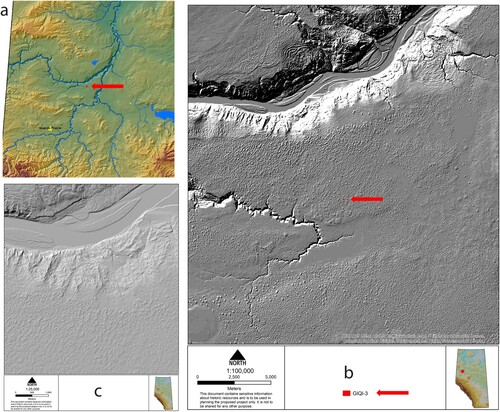
The landform upon which the Poohkay site occurs consists of semi-regularly spaced hummocks, 10–30 m in diameter, typically with some 10–20 m between crests (Liverman Citation1989, 51–61; Citation1991). The surrounding terrain is otherwise flat. This fine-scaled, reticulate surface extends over literally hundreds of square kilometers such that there are many thousands and perhaps millions of such small terrain features ((b,c)). The terrain resembles hummocky disintegration moraine but the hummocks are composed of silts and clays, with laminations that are folded and faulted. Such patterns are consistent with the floors of ancient glacial lakes in other parts of North America apparently resulting from processes of mass movement, where glacial lake sediments are near major rivers, and hence, the lowest parts of glacial lake basins (Liverman Citation1989, 51–61). Lateral stresses result in vertical deformation of sediments subsequent to drainage, creating the undulating terrain (Liverman Citation1989, 51–61).
2.1. Peace Country paleoenvironments
Pedersen et al. (Citation2016) concluded that the Peace Country constriction in the deglaciating Corridor became biotically habitable only at 12,600 cal yr BP, even then dominated by Glacial Lake Peace. This perspective did not account for existing radiocarbon dates on a bison from the Chetwynd area of northeast British Columbia (OxA-11274, 11,240 ± 70 14C yr BP calibrating between 13,065 and 13,307 cal yr BP), a horse from the Elmworth area of northwestern Alberta (OxA-14270, 11,205 ± 90 14C yr BP, calibrating between 12,912 and 13,300 cal yr BP), a date of 11,700 ± 260 14C yr BP (SFU-223, calibrating between 13,087 and 14,267 cal yr BP) on a 3-cm diameter Populus fragment from Boone Lake in northwestern Alberta, or the presence of an eastern Beringian clade bison that had reached the Edmonton area far to the south by 11,115 ± 25 14C yr BP (UCIAMS-125531, calibrating between 12,965 and 13,103 cal yr BP) (Heintzman et al. Citation2016; Shapiro et al. Citation2004; Weinstock et al. Citation2005; White and Mathewes Citation1986).
It is also clear that the LIS had rapidly retreated to the Canadian Shield by ∼13,000 cal yr BP (Dalton et al. Citation2023; Margold et al. Citation2019; Norris et al. Citation2021, Citation2022, Citation2023). Sometime between ∼12,600 and 12,900 cal yr BP, a massive outburst from the northwest arm of Glacial Lake Agassiz in northwestern Saskatchewan carried debris to the Arctic Ocean (Froese et al. Citation2019; Murton et al. Citation2010; Norris et al. Citation2021, Citation2022, Citation2023; Reyes et al. Citation2022). This could not have taken place if Glacial Lake Peace persisted far to the west ∼12,600 cal yr BP. The Peace Country was biotically habitable no later than 13,200 cal yr BP (Froese et al. Citation2019).
The Charlie Lake Cave faunal materials, as well as the sedDNA and pollen records from Charlie Lake, Boone, and Spring Lakes, indicate that a cold, open environment prevailed in the Upper Peace region up to 12,600 cal yr BP, succeeded by aspen parkland ∼11,500 cal yr BP (Pedersen et al. Citation2016; White and Mathewes Citation1986). Early versions of relatively closed boreal and alpine forest appeared in the broader region ∼10,000 cal yr BP. Large areas of the Peace River Basin nevertheless retained aspen parkland and prairie conditions. In 1793, Alexander Mackenzie (Citation1971, 154, 161) remarked on vast herds of elk and bison, poplar groves, rich dark soils, and quantities of dung like a “stall-yard.” Fluted points occur across the former floor of Glacial Lake Peace, including the immediate GlQl-3 vicinity, indicating that Indigenous ancestors were present no later than Younger Dryas times (Ives et al. Citation2019).
3. Artifact recovery
Until cultivated in 1950, GlQl-3 remained unbroken land covered in aspen trees. Mr Poohkay found the majority of the artifacts within the depression at the knoll’s crest. He facilitated recovery of the rare lithics by ploughing the knoll deeply at least once, and was emphatic that the quartzite artifacts comprising the GlQl-3 collection were specifically associated with this small knoll; the few artifacts found just outside the knoll top’s surface depression were moved by cultivation.
Mr. Poohkay was an assiduous collector. There are no debitage items in the collection, artifacts are of a single toolstone, and there are no indications of mid- to late Holocene occupation. Archaeologists also visited the site on different occasions, scouring its surface carefully, with the same results: no debitage, no additional raw materials, and no other indication of later period occupations. Surface collecting in 2006 revealed a point tip that refit with a pre-existing point midsection (GlQl-3:13 and 23). A 2008, 2 × 1 m excavation unit (with fine screening of the clay and silt deposits) was sterile and confirmed that cultivation had created a plow zone that extended to sterile C horizon parent geological materials (Ives et al. Citation2013). All of the factors noted above – along with a suite of technological traits detailed below – point to the collection being a lost tool kit or a cache (sensu lato).
4. The Poohkay collection
The GlQl-3 collection consists of 24 specimens ( and ). There are 15 preforms or fragments thereof: eight are relatively complete, three are bases, two are midsections, and two are tips. With one refit these individual specimens would have comprised at least 12 late-stage point or knife preforms or blanks. The thirteenth instance is a more finished point or knife (GlQl-3:5). There is one fragment of a larger biface, the tip of another biface, one knife-like biface, one burin, three unifacially retouched fragments (two of which refit to form a larger flake tool), and one edge-modified flake fragment.
Figure 2 Unpatinated or lightly patinated surfaces of all the Poohkay (GlQl-3) artifacts recovered to date. Photographed courtesy of the Royal Alberta Museum.
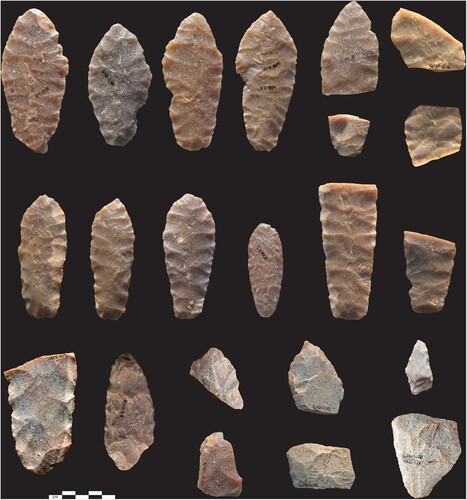
Table 1 Metric data and descriptions for all GlQl-3 (Poohkay collection) artifacts.
4.1. Raw materials
The GlQl-3 collection consists exclusively of vitreous quartzite occurring in three slight variants: (1) a homogenous, gray to honey-colored quartzite with rare or absent dark fleck inclusions; (2) the same quartzite with frequent dark fleck inclusions; and (3) that same quartzite with “granular” globular patches. These quartzites are widely available in exposures along streams and lakes in northern Alberta, likely having been transported eastward from Cordilleran sources by ancient Tertiary and Quaternary watercourses (personal observation; Gryba Citation2001). The black flecks are chert; they are rare enough in the more homogenous quartzite variety that it requires a detailed inspection of an artifact to find them; they can be absent altogether in smaller artifacts. This raw material is present in assemblages extending from northeastern British Columbia to northern Saskatchewan (e.g., Fladmark Citation1981, 133; Ives Citation2017; Landals Citation1994). The granular patches in the third variant appear to reflect spots in which metamorphic processes were less intense. Most of the Poohkay assemblage consists of this less common variety of quartzite rather than the homogenous variety.
These quartzites commonly comprise 50–75 per cent of the raw materials in use in northern Alberta, (e.g., Ives Citation1985, Citation2017). Gryba (Citation2001) has referred to this material, which has above-average knapping suitability, as “Northern Quartzite.” Skilled craftspersons could exert exquisite control over the flaking process for these quartzites. These qualities are notable in the very large, thin biface from Sexsmith, Alberta (Supplementary Material [SM], Section 1, Figure S1), as well as the Arctic Small Tool tradition materials described by Ives (Citation2017), the latter instances being thinned to the point of translucency. The Sexsmith biface is not directly related to the GlQl-3 materials but comes from the same region; it shows how large these quartzite cobbles could be. With its thin configuration and broad, expanding flake scars, it is indistinguishable from some of the large Fenn Cache and Anzick Clovis bifaces (cf. Frison and Bradley Citation1999; Ives et al. Citation2013; Wilke, Flenniken, and Ozbun Citation1991).
4.2. Patination
Three aspects of the toolstone in the collection provide additional insights into the age and structure of the collection. The Poohkay preform specimens all have patination on one or both surfaces, providing a relative index of antiquity. This patination has been termed “oolitic” or “tapioca-like” because quartz grains within the quartzite remain vitreous and clear while the interstitial matrix of the quartzite takes on a creamy appearance that is opaque () and ). The patination is surficial: occasional plow chips reveal uniform, vitreous quartzite beneath. Several fluted points as well as other early period forms made of the same quartzite have patination. It is a rough indication of antiquity seldom observed on later artifacts in northern Alberta (e.g., Ives et al. Citation2019; SM, Section 1, Figure S2).
SEM spectra were generated for the GlQl-3 artifacts with a Zeiss Sigma 300 VP-FESEM. (Details for the SEM analysis are provided in SM, Section 2.) These studies involved the individual quartz grains in the GlQl-3 quartzite, the patinated interstitial matrix in which the grains are suspended, unpatinated interstitial matrix, and freshly chipped surfaces resulting from minor plow damage. There were no substantive differences among the unpatinated matrix, the freshly chipped surface, and individual quartz grains within the matrix: all were dominated by Si and O peaks (see (b,c) and SM Figures S2–S8).
Figure 3 (a) Low magnification of patinated surface of GlQl-3:11 showing how quartz grains remain clear, while interstitial matrix turns a cream color. The arrow in (a) shows rounding created by the abrasion of arrises and edges of this artifact; (b) SEM image showing the abrasion affecting an arris on GlQl-3:2; (c) SEM image of GlQl-3:2 showing quartz crystals and matrix within a plow damage chip, where abrasion on the arris is absent; (d) Quartz grains and patinated matrix sampled on GlQl-3:2. Note the conchoidal microfracture occurring across the matrix and quartz grain, upper center, as well as the particles adhering to the matrix surface between the quartz grains. Photographed courtesy of the Royal Alberta Museum.
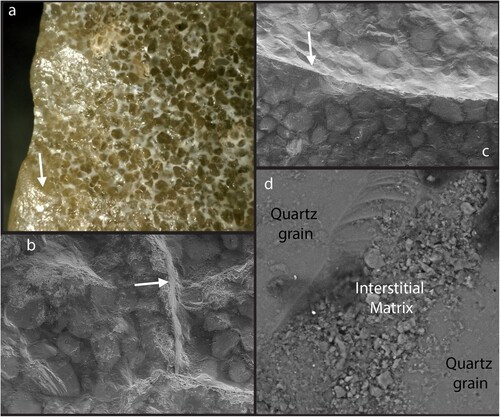
The patinated matrix yielded a range of other elements, including Ca, K, Cl, Fe, Na, Mg, Ti, and Al – a suite normally associated with clay matrices. (d) shows a concentration of particulate matter on the matrix between the two quartz grains – likely adhering clay minerals. The patina on the Poohkay artifacts results from an additive rather than subtractive process, in which pedogenic conditions either mechanically or chemically altered the matrix surface, adding elemental complexity, but in a fashion that left quartz grains unaffected.
Aspen cover in this region of Alberta typically features Gray Wooded soils. It is very likely that luvisolic soils, featuring lower pH values with eluvial processes translocating organics and colloidal soil fractions downward, were influential in the formation of the quartzite patinas observed on these and other northern Alberta quartzite artifacts (Lavkulich and Arocena Citation2011, 785–786). Apart from taxonomic considerations outlined below, it is reasonable to conclude that patination of this quartzite material is independent evidence of some antiquity, coming from terminal Pleistocene or early Holocene times.
4.3. Thermal alteration
Placing Northern Quartzite samples in or near red hot coals causes both matrix and grains in this raw material to shift to an opaque white color throughout the artifact (Ives Citation1985, 34). Five Poohkay specimens were affected by significant heating. This pattern occurs frequently on early-period specimens made from this quartzite in northern Alberta and Saskatchewan (, ), and (a–c)). The larger biface (GlQl-3:14) was heated so intensely that it has rusty hues and a thermal aureole. Mr Poohkay recalled collecting it north of the GlQl-3 knoll, near a wooded depression, where it may have been affected by burning of scrub piles from land clearing activities after having been displaced.
It is not necessary to heat treat this quartzite to achieve superior flaking results. There is a dichotomy in the assemblage structure: the other four heated artifacts (GlQl-3: 15, 20, and the 19/21 cross mend) were heated less intensely. All of the heated artifacts feature frequent black chert flecks and some oxidation, but none of the late-stage point preforms do. The heating causes a distinctive speckled black and white pattern. It is conceivable that the heating was purposeful and served an aesthetic purpose for toolstone with frequent chert flecks. All of the artifacts were not subjected to intense heat as a group, therefore.
4.4. Transport wear
The images in (a,b) show rounded arrises and edges, contrasting with the sharp edges caused by plow damage ((c)). This smoothing of the GlQl-3 artifacts is noticeable in handling the collection: virtually every flake scar is marked by this effect. This abrasion is consistent with the “bag” or “transport” wear described for caches (e.g., Bement Citation2014, 72–73; Huckell et al. Citation2002). The GlQl-3 artifacts arrived at the site in some type of container that allowed artifacts to rub against each other or the container.
4.5. Complete points and preforms (8)
The dominant theme in the GlQl-3 assemblage is one of bifacial reduction of artifacts leading to large projectile point or knife forms (see Smith et al. Citation2024 regarding the likelihood of large Parman forms were actually intended as knives, at least early in their use life). Eight of the specimens are complete; the patinated and unpatinated surfaces of these eight are illustrated in (Table S1). The slight color variation (with GlQl-3:5, 7 and 12 more toward the gray end of the spectrum and the remaining artifacts somewhat more pale “honey” colored) would suggest that two or three raw material cobbles were involved. In seven of these cases, the shaping process had not been completed. The proximal stems are lightly to moderately ground, and even that may be from transport wear or platform preparation rather than the heavy grinding typical of many PaleoIndigenous haft elements. A majority of bases and tips are unfinished, with no finer retouch trimming the edges of these specimens. Consequently, it is more appropriate to term the seven instances late-stage preforms or blanks. The eighth specimen, GlQl-3:5, is complete, has had its tip repaired, and is smaller but thicker, with finer edge retouch.
Figure 4 The non-patinated (or very slightly patinated) and patinated sides of the eight complete point preforms or points: top row, from left: (a) GlQl-3:2; (b) GlQl-3:3; (c) GlQl-3:4; (d) GlQl-3:7; (e) GlQl-3:9; (f) GlQl-3:10/11; (g) GlQl-3:12; and (h) GlQl-3:5. Photographed courtesy of the Royal Alberta Museum.
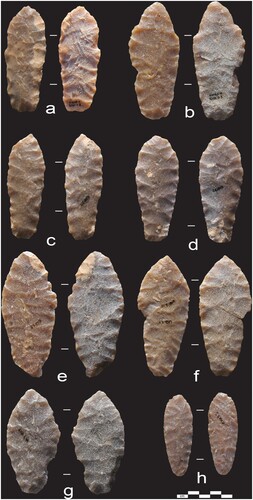
4.6. Preform fragments (7)
The largest of the three base fragments, GlQl-3:6, is missing its tip but is larger than the complete preforms ((a,d)). The GlQl-3:6 base fragment is nearly as large as an elegant Hell Gap point from Wally’s Beach in southern Alberta (Figure S9); if it were to be projected forward with the same morphology as the Wally’s Beach specimen (the overlay on the right, Figure S10), the entire artifact might have been as long as 180 mm. The Poohkay preforms are not “hypertrophic” at the same scale as the Wenatchee fluted points in Washington, but would certainly have made for formidable weaponry, whether points or knives.
Figure 5 (a–c) Unpatinated side of preform base fragments GlQl-3:6, 17, and 24; (d–f) patinated side of the same three artifacts. The GlQl-3:10/11 tip and middle fragment and the GlQl-24 base might have been part of a single preform. Photographed Courtesy of the Royal Alberta Museum.
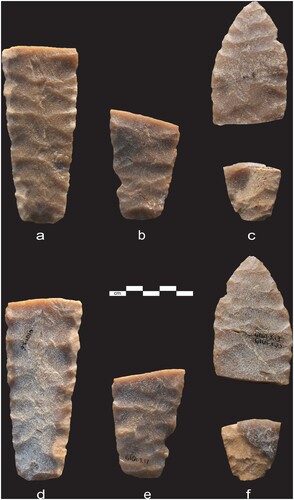
GlQl-3:17 is the basal half of a preform ((b,e)); GlQl-3:24 is a small base fragment ((c,f)). GlQl-3:24 does not refit with any other preform fragments, but its contours would be consistent with the outline of the GlQl-3:13/23 refit (as arranged in (c,f)). They may all be part of a single artifact although GlQl-3:24 could also be a part of either the artifact from which GlQl-3:16 or 20 came (below).
GlQl-3:16 is a midsection fragment that captures a portion of the stem as it extends into a more flaring blade. Figure S12 projects this fragment against the GlQl-3:10-11 refit to indicate its expected position on a complete preform with a broader blade. GlQl-3:20 is also a midsection fragment; it comes from farther down the stem of the original preform, as projected against the GlQl-3:10-11 refit (Figure S13).
4.7. Reduction strategies for the point preforms
The point preforms likely began with percussion flaking of larger bifaces followed by highly skilled pressure flaking that eliminated most traces of previous percussion flaking. provides line drawings of GlQl-3:5, GlQl-3:7, and GlQl-3:2, along with photographs of each face of these artifacts. The general strategy in creating the preforms (GlQl-3:2 and 7) was to detach broad, parallel-sided or expanding flakes that met irregularly near the preform midline. GlQl-3:5 differs from the other two examples by virtue of its smaller size, greater thickness, regular edge outline, and on one surface, better-organized collateral flaking meeting at the midline.
Figure 6 Both faces and line drawings of GlQl-3:5 (top), GlQl-3:7 (middle), and GlQl-3:2. Photographed courtesy of the Royal Alberta Museum.
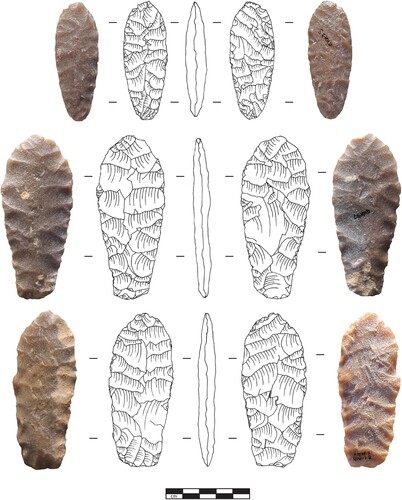
The GlQl-3 point preforms have been expertly thinned, as revealed by backlighting ((a,c)), where artifacts remain translucent for nearly a centimeter from trimmed but irregular edges. Cross-sectional shapes are lenticular, as the broken midsection of GlQl-3:6 shows in (b).
Figure 7 (a) Backlighting of GlQl-3:6; (b) lenticular cross section of GlQl-3:6; (c) backlighting of GlQl-3:7; (d) remnant facet at the tip of GlQl-3:4; (e) and (f) overshot flaking at the tip of the GlQl-3:13/23 refit. Photographed courtesy of the Royal Alberta Museum.
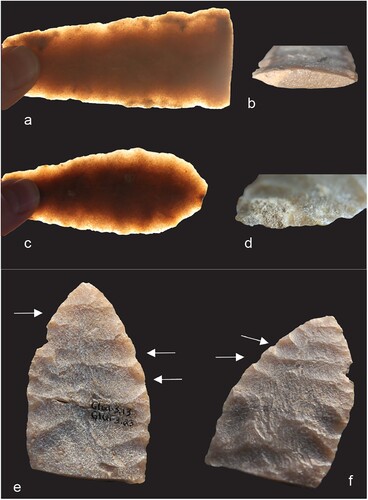
The preforms were unfinished. Of the nine point tips we can examine, two (GlQl-3:10/11 and GlQl-3:13/23) are reasonably well-shaped by oblique pressure flaking, leaving a sharper tip, presumably reflecting the intended tip morphology. Those two examples have no fine retouch trimming, however. The remaining point tips (GlQl-3:2, 4, 7, and 9) feature unaltered flake facets or slightly bulbous, ground-striking platforms (GlQl-3:2 and 12) (e.g., (d)).
There is a shift in the pressure flaking pattern for the preform tips. Over most of the proximal portion of the preforms, there is co-medial flaking converging at the midline of the specimen. Toward the tip, flaking begins to extend more across the specimen, and in some cases (see GlQl-3:13/23 in (e,f)) becomes outrepassé (overshot).
The bases of GlQl-3:6, 7 and 17 are simply flaked (without retouch) but relatively neatly squared off, or for GlQl-3:5, rounded. Bases were created by an angled flake scar left unaltered, or by a few obliquely angled, smaller flake scars. GlQl-3:9 has the most irregular base, but inspection of the patinated surface shows that it has suffered plow damage. Even so, it retains a portion of a facet oriented more perpendicularly to the preform, as can be determined from the patination of the remnant facet.
4.8. Other bifacial forms (3)
GlQl-3:14 represents roughly 60 per cent of a biface with a thermal aureole ((a)). The quartzite had frequent dark flecks and is marked by broad, expanding flakes that tend to meet near the midline. Negatives from the bulbs of percussion are deep, reflecting direct percussion and resulting in coarser edge sinuosity. Some striking platforms are isolated. Arrises exhibit rounding that can be attributed to transport wear. This artifact could have been intended to be a knife or an early-stage preform.
Figure 8 Both surfaces of: (a) biface fragment GlQl-3:14; (b) biface tip GlQl-3:18; and (c), shouldered biface GlQl-3:8. Photographed courtesy of the Royal Alberta Museum.
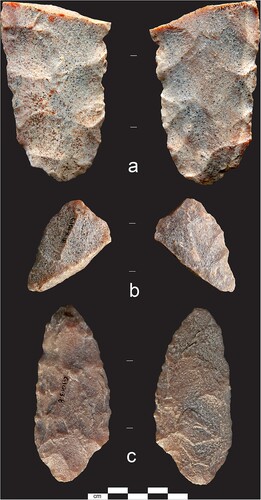
GlQl-3:18, the tip of a large biface, does not refit with GlQl-3:14: the former is simply patinated whereas as the latter was intensely heated. This tip fragment also has no dark inclusions whereas GlQl-3:14 has many ((b)). The fragment either came to the site in its present form, or is part of another large biface not yet recovered. It also has coarse edge sinuosity and isolated platforms.
GlQl-3:8 is an asymmetrical, thicker biface fashioned from a more opaque version of the quartzite ((c)). The proximal portion of this artifact has had large flakes removed, leaving a tanged effect that might have allowed for hafting. Although not as finely flaked as the one illustrated by Irwin and Wormington (Citation1970, 28–29), this biface is quite like their “Hell Gap knife” (see also Irwin Citation1967, 252–261, and especially Figure 75, as well as the shouldered biface in the McNine collection (Amick Citation2004). These are asymmetrical specimens with one or two sloping shoulders and a short stem. The excurvate edge of GlQl-3:8 has fine trimming with limited sinuosity. The straighter edge and the tang have more wear or grinding. Arrises evidence the same rounding that can be attributed to transport wear in other Poohkay artifacts.
4.9. Flake tools (4)
The three unifacially retouched flakes in the Poohkay assemblage are heat-altered to an opaque off-white highlighting mafic flecks ((a–c)). GlQl-3:15 was formed when a thick flake was broken and then served as a unifacial tool. GlQl-3:19 refits with GlQl-3:21 to make up a large unifacial implement ((b)). It retains a facetted striking platform that likely came from a bifacially flaked core, with a clearly defined bulb of percussion and accompanying éraillure scar. This large flake tool is reminiscent of larger Agate Basin, Hell Gap, MacHaffie site and Vermilion Lakes flake tools (Fedje et al. Citation1995; Frison Citation1982, 107–114, 139, figures 2.83; Knudson Citation1983; Kornfeld Citation2009, 244, figure 16.1). GlQl-3:25 is a small flake of heated quartzite that retains a facetted striking platform, the sides opposite of which converge to a point, with both edges featuring unifacial retouch ((c)) (cf. Kornfeld Citation2009, figure 16.1, d, a similar tool from the Hell Gap site’s Agate Basin subphase).
Figure 9 Both surfaces of: (a) unifacial flake tool GlQl-3:15; (b) unifacial flake tool GlQl-3:19/21; (c) unifacial flake tool GlQl-3:25; and (d) burin GlQl-3:22, where white arrows indicate the direction of the burin blow and the red arrows indicate the facets at opposite ends of an overshot flakes. Photographed courtesy of the Royal Alberta Museum.
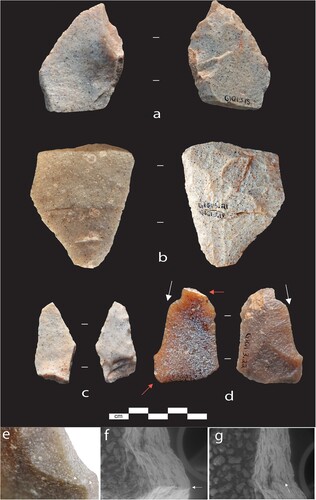
GlQl-3:22 is an overshot flake in which the striking platform and distal termination are each facetted and heavily ground, reflecting the opposite edges of the biface from which it was struck ((d)). The bulb of percussion is distinct; the flake has a significant degree of longitudinal curvature. While GlQl-3:22 is vitreous gray rather than cream-colored in appearance, a few dark inclusions are present. This artifact came from a raw material similar to, but not identical to the large biface (GlQl-3:14) and unifacial forms, where the chert inclusions are more frequent. A burin blow has been struck from a notch along one lateral margin of this flake. The burin spall terminates at a dorsal arris, the juncture having wear and longitudinal striae running parallel to the direction of the burin blow, suggesting repetitive, directional use ((e–g)).
5. Taxonomic affinities of the GlQl-3 assemblage
5.1. Agate Basin and Hell Gap
One obvious comparison for the preforms would be the Agate Basin-Hell Gap morphological continuum. Bradley (Citation1993, 257–258; Citation2009, 264–268; Citation2010; Guarino Citation2018) regarded Hell Gap projectile point manufacture as similar to that of Agate Basin, in which there was percussion reduction of a biface with finishing of the entire point through pressure shaping. In Hell Gap instances, the production process was arrested at an earlier stage, leaving a broader blade and tip area (Bradley Citation1993, Citation2009; Frison Citation1974). Percussive thinning on the Poohkay specimens has largely been obliterated by lateral edge pressure flaking reaching the midline of the perform. Base and stem grinding is light where present. The chief distinction between Hell Gap and Alberta points lies in the greater lateral inflection defining an angled shoulder for Alberta points. Figure S13 shows the large St. Mary Reservoir Hell Gap point, two of the GlQl-3 point blanks, and an Alberta point from the Holroyd collection, also from northwestern Alberta, where the distinctions to which Bradley referred are evident in the continuity of flaking patterns. Cody Complex materials are well represented in Peace River surface collections. Sellet (Citation2001) has shown at stratified sites that Hell Gap points overlap stratigraphically with other point forms (notably Agate Basin, Goshen and Folsom at the Hell Gap site itself (Larson et al. Citation2009)). Hell Gap points thus have both a transitional morphological and chronological character.
5.2. Western Stemmed Tradition
The GlQl-3 assemblage also shows affinities to the Western Stemmed Tradition series of points (e.g., Bryan Citation1980; Butler Citation1965; Jones et al. Citation2003; Smith et al. Citation2020; Rosencrance Citation2019). Projectile points or knives termed “Haskett,” “Parman,” “Cougar Mountain,” and “Lake Mojave,” can show remarkable similarity to lanceolate forms in Alberta and Saskatchewan (see Ives, Citation2024, this issue). The Poohkay preforms are most similar to Haskett and Cougar Mountain forms (Butler Citation1965; Duke Citation2015; Rosencrance Citation2019). Of many possible comparisons, Willig’s (Citation1988) Figure 37i (#490-64-179) bears a striking resemblance to GlQl-3:12; for this and (e–g), there is a decided similarity to Haskett forms.
In reduction details, the Poohkay materials can be compared to the McNine cache recovered from a cave in northwestern Nevada (Amick Citation2004). Amick (Citation2004, 127) categorized the projectile points as Parman based on their symmetry, prominent shoulders, and stem grinding. It was comprised of six projectile points, four late-stage preforms, five early-stage preforms, two ovoid bifacial blanks, a triangular preform and a scraper. All artifacts were made of obsidian from multiple sources within 100 km of the findspot. He felt the points had not seen use because they retained blunted, lightly ground tips – either as a form of protection during transport, or, as a step prior to the creation of a tranchet tip occasionally occurring on Western Stemmed points (including the stemmed point found with the 10,675 ± 95 14C yr BP Buhl woman in Idaho) (Green et al. Citation1998; but see Jazwa et al. Citation2021 regarding the accuracy of this age determination). The McNine points are larger than typical Parman varieties. All of the McNine points have a greater degree of shouldering in creating a stem. In terms of overall morphology, the four McNine late-stage preforms are most similar to the Poohkay materials. The Poohkay preforms appear to have somewhat better organized comedial flaking than the McNine specimens but are otherwise constructed in a similar fashion.
It is not difficult, then, to imagine that finished points from the preforms would resemble Agate Basin, Hell Gap or Haskett forms, as illustrated with other examples of the same vitreous quartzite in , with the chief source of variability lying in the distal breadth of the preform. Preforms with a narrower blade could be finished in somewhat more of an “Agate Basin” direction, whereas it takes no imagination to see that those with a broader blade and more finished tip could become Haskett or Hell Gap forms. Comparisons to southern Plateau and Great Basin forms are warranted by obsidian sourcing studies for early period artifacts in northwestern Alberta, where Bear Gulch (Idaho) and Glass Buttes (Oregon) sources are reflected in artifacts including a fluted point preform and a reworked stemmed point base (Kristensen et al. Citation2023).
Figure 10 Top left, a narrower preform, GlQl-3:2, which with further finishing could have outcomes like the vitreous quartzite Graham collection point (from northwestern Saskatchewan) to its right, or the Agate Basin-like point from the Grande Prairie Museum collections, farthest right. Bottom left, GlQl-3:10/11, a preform with a broader tip toward its distal end, with possible outcomes like the cast of an Old River Bed Delta (Utah) Haskett point to its right, or a vitreous quartzite point (FiPp-33:13302) from the lowest component of Ahai Mneh in central Alberta, farthest right (see Ives Citation2023). Photographed courtesy of the Royal Alberta Museum.
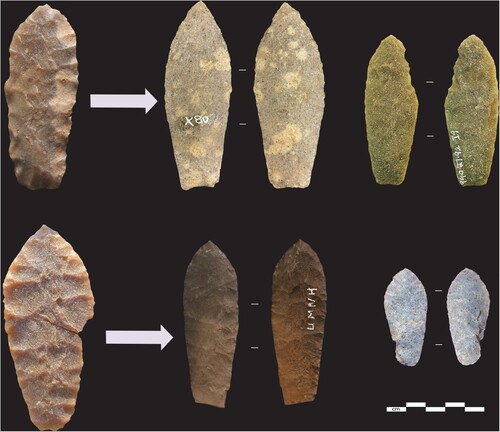
5.3. An Alaskan connection?
The GlQl-3 preforms have a general resemblance to Sluiceway points from sites like Tuluaq Hill, Caribou Crossing 1, and Irwin Sluiceway in North Slope locales in Alaska (Rasic Citation2000, Citation2003, Citation2011). Sluiceway bifaces can be distinguished by their marked thickness, with a sample of 132 Sluiceway points averaging 13.0 mm (data courtesy Jeffrey Rasic, pers. comm.); they consistently feature quite narrow or even convex bases. Rasic (Citation2000, 267–271) considered that Sluiceway bifaces began as longer lanceolate points that – through repair and sharpening – became smaller, oblanceolate knives later in their use life.
The Sluiceway resemblance can be regarded as superficial for all but one of the Poohkay specimens: GlQl-3:5 (). Although re-tipped, at 12.3 mm, GlQl-3:5 is more than 20 per cent thicker than the Poohkay preforms. While broad flakes on the other GlQl-3 point blanks meet irregularly in the middle of those artifacts and sometimes overshoot, the GlQl-3:5 flakes are narrower and consistently meet at the midpoint of that artifact, creating a ridge-like effect in a thick, lenticular profile. GlQl-3:5 is indistinguishable from many Sluiceway points (see Ives, Citation2024, this issue, for other Alberta examples).
Figure 11 (a) Three views of GlQl-3:5 and (b-e), four typical Sluiceway points from the Caribou Crossing 1 site, Alaska. GlQl-3:5 photographed courtesy of the Royal Alberta Museum; Caribou Crossing 1 photograph courtesy Jeffrey Rasic.
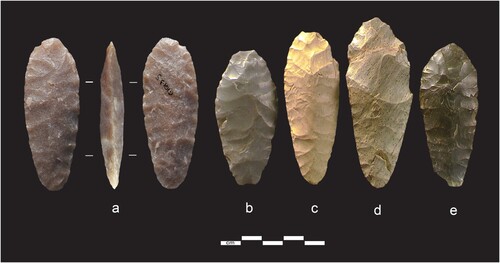
One might suspect that GlQl-3:5 is not directly associated with the other Poohkay artifacts. Nevertheless, there should be other artifacts with different characteristics if GlQl-3 is a palimpsest. One must take into account just how many thousands of instances of the “humpie” landform there are in the region and consequently, just what the chances would be of re-occupation of this particular terrain feature. GlQl-3:5 has a fainter degree of patination, but so do GlQl-3:4, 5 and 7. Variability in the pedogenic environment doubtlessly contributed to differing degrees of patination. The fainter patination on GlQl-3:5 is therefore not a sound reason for thinking it does not belong with the other point blanks.
There may be some temptation to speculate that GlQl-3:5 actually represents the intended end form for Poohkay's performs. Yet, the unfinished Poohkay preforms are already ∼20 per cent thinner than GlQl-3:5, whereas one would expect continued elaboration of a preform to result in even greater thinning. The extent to which GlQl-3:5 is an outlier is illustrated in , plotting the length-to-thickness and width-to-thickness ratios for the eight complete Poohkay points along with means for the same ratios for the Sluiceway sample, the Casper and Hell Gap site points, and the McNine site preforms and Parman points (Table S2). GlQl-3:5 has much lower ratio values owing to its greater thickness and aligns closely with Sluiceway point values. The other Poohkay point blanks share values more similar to those for finished Hell Gap points and McNine points and preforms and would be expected to move more toward those latter values as they were finished.
Figure 12 Top, length to thickness, and bottom, width to thickness, ratios for GlQl-3:5 and the other Poohkay preforms, presented with mean Sluiceway, McNine, Casper, and Hell Gap site values, showing how GlQl-3:5 is much closer to typical Sluiceway values, while the other Poohkay point blanks are closer to Western Stemmed Point tradition and Hell Gap values.
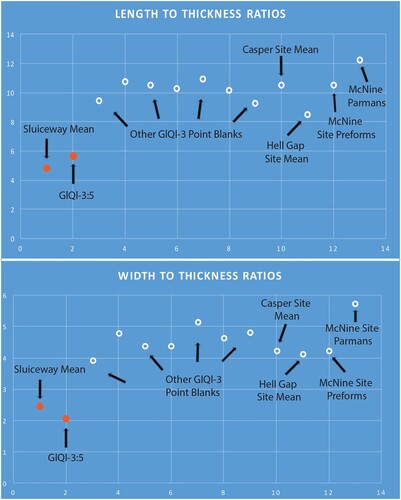
Again, obsidian sourcing studies for early period artifacts in northwestern Alberta warrant this northern comparison: one lanceolate point from the Peace Country, resembling Agate Basin forms, has been sourced to Batza Téna in Alaska (Kristensen et al. Citation2023, 15, ).
6. Discussion
6.1. Age
It is not presently possible to assign a precise age to the Poohkay collection. It may be as early as ∼13,200 or as late as the more recent end of the stemmed point time range, ∼8500–9000 cal yr BP. Given the morphological characteristics of the point preforms, it would seem most likely that they were left behind in the general time range of the two stratified and radiocarbon-dated sites currently known in the region: Tse’K’wa (Charlie Lake Cave, HbRf-39) in northeastern British Columbia and Saskatoon Mountain (GhQt-4) in northwestern Alberta. The earliest deposits at Tse’K’wa range from 9490 ± 140–10,560 ± 60 14C yr BP (∼10,600–12,500 cal yr BP) (Driver et al. Citation1996; Heintzman et al. Citation2016), with a small, basally thinned point in the lowest component and microblade cores present in slightly later components. The lowest deposits at Saskatoon Mountain yielded radiocarbon dates on charcoal and Rubus sp. (raspberry) and Rosa sp. (rose) seeds from a hearth (AECV-1474C: 9380 ± 360; UCR-3275, CAMS 12365: 9360 ± 60 14C yr BP) (∼10,500 cal yr BP, Beaudoin, Wright, and Ronaghan Citation1996). Eclipse Phase shouldered and stemmed points from sites in the Banff area are also dated to an interval spanning 9600–9900 14C yr BP (∼11,000–11,500 cal yr BP) (Fedje Citation1988, Citation1996).
No early-period stemmed points were discovered at Tse’K’wa or Saskatoon Mountain, but together they suggest small residential groups were engaged in activities ranging from hunting forays and meat storage at Tse’K’wa to use of extraordinary view planes from overlook locations at both sites (Driver Citation1999; Driver and Vallières Citation2008). These factors suggest the presence of settled-in populations in the region, consistent with Hell Gap or Haskett time ranges, as environmental conditions shifted from cooler, open environments to the regional advent of more closed boreal forest settings (Driver Citation1999; MacDonald and McLeod Citation1996; Pedersen et al. Citation2016). The early presence of articulated raven skeletons connected with microblade cores at Tse’K’wa, perhaps parts of bundles, may indicate early-period ceremonial activities.
6.2. Reasons for the site location
There are two subsistence-related reasons for human use of the site setting: hunting of terrestrial herbivores potentially vulnerable to strategies involving the undulating landscape, or, foraging for waterfowl nests, principally for eggs. These strategies need not have been mutually exclusive, and it is conceivable that the Poohkay artifacts could have been left behind or lost in such activities.
There is a statistically significant association between lacustrine sediments and fluted points in the greater Corridor region, where fluted points tend to occur within former proglacial lake basins (Ives Citation2006; Ives et al. Citation2013, Citation2019). Huge areas would have contained glacially ground sediments of Canadian Shield origin, rich in phosphorus and potassium, while both glacial ice and lake waters are fixed nitrogen sources. An initial flush of vegetative growth may have been of high quality (cf. Turner et al. Citation1999). Such conditions quite likely persisted into the later Younger Dryas and early Holocene when the Poohkay artifacts were likely deposited, bearing in mind that the Peace Country would remain a parkland-prairie isolate within the incipient, surrounding boreal forest biome that emerged in the early Holocene. The seasonal potholes and undulating terrain of the former Glacial Lake Peace basin would have allowed for encounter hunting of contemporaneous bison chronospecies and wapiti in the region (Burns Citation2010, 39; Heintzman et al. Citation2016).
The Peace Country landscape would have been ideal for waterfowl populations. Williams and Webb (Citation1996) illustrated how the late Pleistocene breeding habitat for North American waterfowl was either compressed south of the coalesced LIS-CIS ice masses at the height of the Late Wisconsinan ∼18,000 cal yr BP, or would have to be reached through migratory flight to ice-free eastern Beringia. By ∼12,000 cal yr BP, larger parts of interior North America provided breeding habitat, but well-watered, deglaciated areas across western Canada were still concentrated in front of waning ice masses that continued to cover the Canadian Shield and Barren Grounds. While there has been a focus on taking waterfowl adults, a phenological burst connected with numerous eggs would surely be welcome to human foraging populations in ways familiar to hunter-gatherer populations in circumpolar Arctic settings (e.g., Kristensen Citation2008; Moss and Erlandson Citation2013).
6.3. A cache, lost tool kit, or votive offering?
The significant technological use value left in the Poohkay collection raises the possibility that it reflects a cache in the “insurance” sense of the term (purposeful stowing of useful materials, obviating the need to return to a lithic source located at a much greater distance). This is unlikely. The quartzites involved have a diffuse distribution in northern Alberta, and suitable cobbles could be encountered anywhere that preglacial sand and gravel deposits were exposed. Such caching would logically take place with reference to recognizable landscape features, allowing ready relocation of a cache. Nothing could be farther from the truth for GlQl-3: relocating such a cache in a relatively featureless terrain with countless thousands of such minor knolls would be impractical even for individuals highly skilled in negotiating such landscapes.
The Poohkay collection could simply be a tool kit misplaced by its makers. The remaining use value of the artifacts would reflect their status when they were inadvertently lost while foraging. There is one other possibility – that the artifacts were an offering, never intended to be recovered by its makers, a possibility Amick (Citation2004) raised for the McNine collection. There may have been an ochre film on some of the McNine artifacts, which were large, had diverse late-stage diagnostics, had not been used and had wear suggestive of transport. Amick (Citation2004, 139) observed that the McNine artifacts had several flaking platforms that “were isolated and prepared but not removed, suggesting that they may have been left intentionally to serve as static representations of the process of Parman point manufacture.”
This intriguing idea has parallels in the Poohkay collection, where the preforms verge upon hypertrophic, there is clear evidence of transport wear, and there is a mosaic of unfinished traits on the preforms. It is conceivable that the preforms could reflect static representations concerning what would be required to produce finished points or knives, and could therefore have had a didactic quality with which experts could mentor novices (see Mønstad et al. Citation2022 for another mentoring example).
The Poohkay collection differs in that there is no ochre present, and there are other artifacts of different forms that had been in practical use. Despite this, the likelihood of heat treatment enhancing the speckled appearance of those artifacts of differing function raises the possibility of an aesthetic or ritual dimension (cf. Deller, Ellis, and Keron Citation2009). Unlike the McNine cache, there is an artifact that seems out of place: the GlQl-3:5 specimen so like a Sluiceway point.Footnote1 Given the presence of microblade technology and Batza Téna obsidian in the region in a terminal Pleistocene-earliest Holocene time range, it is possible that this artifact reflects some degree of interaction between eastern Beringian and Corridor populations. The Poohkay assemblage may simply reflect an incidental loss, but there is a possibility that the unusual location and artifact characteristics could reflect ceremonial or symbolic activities.
7. Conclusions
The beautifully crafted Poohkay artifacts can stimulate critical thinking about the complex human interactions involved in our evolving understanding of the Ice-Free Corridor, and relevant to the topic of our symposium – the expansive role of shoulderless stemmed points in the wake of North America’s fluted point era. While we cannot determine the precise age of the Poohkay collection, its morphology and regional settlement data plausibly suggest that it would come from the Younger Dryas or earliest Holocene. The GlQl-3 point preforms would then fall between the end of the fluted point era and the onset of more distinctly shouldered Cody Complex points, particularly the Alberta points common in Peace Country collections, where similar construction details persist.
To the extent that the GlQl-3 artifacts may be allied with the Agate Basin-Hell Gap-Haskett continuum, they may also shed light on some poorly understood aspects of northern archaeological records. The Poohkay preforms are shoulderless, but nevertheless share distinctive flaking patterns with Alberta points that are well represented in northwestern Alberta. Although dated, stratified sites like Fletcher in Alberta and Heron-Eden in Saskatchewan are rare in the larger Ice-Free Corridor region, it is conceivable that the remarkably high density of Cody Complex diagnostics in the expanded Corridor figured significantly in this transition to more distinctly stemmed points (Vickers and Beaudoin Citation1989; Corbeil Citation1995). It is also possible that the Poohkay assemblages could be connected with the subsequent appearance of Agate Basin-like points in the Northwest Territories, the Yukon and Alaska (e.g., Anderson Citation1970; Gordon Citation1996). The Keewatin ice dome lingered over the Barren Grounds where deglaciation continued as late as 8000 cal yr BP (Dalton et al. Citation2020). There, the very last near-glacial conditions persisted with perhaps the last echo of a PaleoIndigenous world. With genetic evidence indicating several late Pleistocene founding lineages, a better understanding of collections like this one, with ties to both the north and south, can help elucidate how the ultimate dominance of a northern (or Native North American) lineage, ancestral to Haida, Tlingit, Tsimshian, Salishan, Wakashan, Dene, and Algonquian communities in Alaska and nearly all of Canada came about (e.g., Willerslev and Meltzer Citation2021; see Ives, Citation2024, this issue for further thoughts in this vein).
SUPPLEMENTARY MATERIAL.docx
Download MS Word (15.8 MB)Acknowledgements
The late Nick Poohkay and Morris Burroughs helped greatly in investigating the GlQl-3 collection. Mr Poohkay donated the entire collection to the Royal Alberta Museum, after which it was loaned to the University of Alberta for subsequent analysis. Mr and Mrs Charles Ulland kindly granted access to the field in which GlQl-3 is located. Darryl Bereziuk (Archaeological Survey of Alberta) held the permit for our 2007 testing of GlQl-3. I am grateful to Bob Dawe and Kyle Forsythe (Royal Alberta Museum) for access to the GlQl-3 materials. Todd Kristensen’s work with avocational collections in the Peace Country over the last several years has been of enormous assistance. Andrew Locock provided valuable advice on patination and heating, while Nathan Gerein (both of Earth and Atmospheric Sciences, University of Alberta) assisted with the SEM imagery and elemental compositions presented here. Justina Smith made the line drawings in . Jeff Rasic (National Park Service, Alaska) and Daniel Amick (Loyola) were most generous in sharing data and illustrations of Sluiceway and McNine artifacts, respectively. Helpful comments from three reviewers were appreciated. My research benefitted from the support of the Landrex Distinguished Professorship.
Disclosure statement
No potential conflict of interest was reported by the author(s).
Additional information
Notes on contributors
John W. Ives
John W. Ives earned his PhD from the University of Michigan. He is an emeritus professor in the Department of Anthropology at the University of Alberta in Edmonton. His research interests include archaeological records of the Plains, Subarctic, Great Basin, and northeast China, PaleoIndigenous studies, Apachean origins, kinship and socioeconomic organization, archaeological theory, and public archaeology. He is the author of A Theory of Northern Athapaskan Prehistory and co-editor of Holes in Our Moccasins, Holes in Our Stories, Apachean Origins and the Promontory, Franktown, and Dismal River Archaeological Records.
Notes
1 This would resemble an aspect of the Fenn cache, with its distinctive “lobed” Clovis points also found at Wyoming’s Colby mammoth site, as well as a crescent, an artifact more characteristic of California and the Great Basin (Frison and Bradley Citation1999).
References
- Amick, D. S. 2004. “A Possible Ritual Cache of Great Basin Stemmed Bifaces from the Terminal Pleistocene—Early Holocene Occupation of Nw Nevada, USA.” Lithic Technology 29 (4): 119–145. https://doi.org/10.1080/01977261.2004.11721016.
- Anderson, D. D. 1970. “Akmak: An Early Archaeological Assemblage from Onion Portage, Northwest Alaska.” In Acta Arctica, 80. København: Munksgaard. https://ehrafarchaeology.yale.edu/document?id=nd60-002.
- Beaudoin, A. B., M. Wright, and B. Ronaghan. 1996. “Late Quaternary Landscape History and Archaeology in the ‘Ice-Free Corridor’: Some Recent Results from Alberta.” Quaternary International 32: 113–126. https://doi.org/10.1016/1040-6182(95)00058-5.
- Bement, L. 2014. “The JS Cache, Clovis Provisioning the Southern Plains Landscape.” In Clovis Caches: Recent Discoveries and New Research, edited by B. B. Huckell and J. D. Kilby, 61–78. Albuquerque: University of New Mexico Press.
- Bradley, B. A. 1993. “Paleo-Indian Flaked Stone Technology in the North American High Plains.” In From Kostenki to Clovis, Upper Paleolithic-Paleo-Indian Adaptations, edited by O. Soffer and N. D. Praslov, 251–262. New York: Plenum Press.
- Bradley, B. A. 2009. “Bifacial Technology and Paleoindian Projectile Points.” In Hell Gap, A Stratified Paleoindian Campsite at the Edge of the Rockies, edited by M. L. Larson, M. Kornfeld, and G. C. Frison, 274–284. Salt Lake City: The University of Utah Press.
- Bradley, B. A. 2010. “Paleoindian Flake Stone Technology on the Plains and in the Rockies.” In Prehistoric Hunter-Gatherers of the High Plains and Rockies, edited by M. Kornfeld, G. C. Frison, and M. L. Larson, 463–497. Walnut Creek, CA: Left Coast Press.
- Bryan, Alan L. 1980. “The Stemmed Point Tradition: An Early Technological Tradition in Western North America.” In Anthropological Papers in Memory of Earl H. Swanson, Jr., edited by L. B. Harten, C. N. Warren, and D. R. Tuohy, 77–107. Pocatello: Special Publication of the Idaho State Museum of Natural History.
- Burns, J. A. 2010. “Mammalian Faunal Dynamics in Late Pleistocene Alberta, Canada.” Quaternary International 217:37–42. https://doi.org/10.1016/j.quaint.2009.08.003.
- Butler, B. R. 1965. “A Report on Investigations of an Early Man Site near Lake Channel, Southern Idaho.” Tebiwa 8 (2): 1–20.
- Corbeil, M. R. 1995. “The Archaeology and Taphonomy of the Heron Eden Site, Southwestern Saskatchewan.” MA thesis, Department of Anthropology and Archaeology, University of Saskatchewan.
- Dalton, A. S., H. E. Dulfer, M. Margold, J. Heyman, J. J. Clague, D. G. Froese, M. S. Gauthier, et al. 2023. “Deglaciation of the North American Ice Sheet Complex in Calendar Years Based on a Comprehensive Database of Chronological Data: NADI-1.” Quaternary Science Reviews 321: 108345. https://doi.org/10.1016/j.quascirev.2023.108345.
- Dalton, A. S., M. Margold, C. R. Stokes, L. Tarasov, A. S. Dyke, R. S. Adams, S. Allard, et al. 2020. “An Updated Radiocarbon-Based Ice Margin Chronology for the Last Deglaciation of the North American Ice Sheet Complex.” Quaternary Science Reviews 234: 106223. https://doi.org/10.1016/j.quascirev.2020.106223.
- Deller, D. B., C. J. Ellis, and J. R. Keron. 2009. “Understanding Cache Variability: A Deliberately Burned Early Paleoindian Tool Assemblage from the Crowfield Site, Southwestern Ontario, Canada.” American Antiquity 74 (2): 371–397. https://doi.org/10.1017/S0002731600048642.
- Driver, J. C. 1999. “Raven Skeletons from Paleoindian Contexts, Charlie Lake Cave, British Columbia.” American Antiquity 64 (2): 289–298. https://doi.org/10.2307/2694279
- Driver, J. C., M. Handly, K. R. Fladmark, D. E. Nelson, G. M. Sullivan, and R. Preston. 1996. “Stratigraphy, Radiocarbon Dating and Culture History of Charlie Lake Cave, British Columbia.” Arctic 49 (3): 265–277. https://doi.org/10.14430/arctic1202
- Driver, J. C., and C. Vallières. 2008. “The Palaeoindian Bison Assemblage from Charlie Lake Cave, British Columbia.” Canadian Journal of Archaeology/Journal Canadien d'Archéologie 32 (2): 239–257. http://www.jstor.org/stable/41103626.
- Duke, D. G. 2015. “Haskett Spear Weaponry and Protein-Residue Evidence of Proboscidean Hunting in the Great Salt Lake Desert, Utah.” PaleoAmerica 1 (1): 109–112. https://doi.org/10.1179/2055556314Z.0000000002.
- Fedje, D. 1988. “The Norquay and Eclipse Sites: Trans-Canada Highway Twinning Mitigation in Banff National Park.” Microfiche Report Series 395. Environment Canada, Parks Service, Ottawa.
- Fedje, D. 1996. “Early Human Presence in Banff National Park.” In Early Human Occupation in British Columbia, edited by Roy L. Carlson and Luke Dalla Bona, 35–44. Vancouver: UBC Press.
- Fedje, D. W., J. M. White, M. C. Wilson, D. E. Nelson, J. S. Vogel, and J. R. Southon. 1995. “Vermilion Lakes Site: Adaptations and Environments in the Canadian Rockies during the Latest Pleistocene and Early Holocene.” American Antiquity 60 (1): 81–108. https://doi.org/10.2307/282077.
- Fladmark, K. R. 1981. “Paleo-Indian Artifacts from the Peace River District.” BC Studies 48 (Winter 1980–81): 124–135.
- Frison, G. C. 1974. The Casper Site. New York: Academic Press.
- Frison, G. C. 1982. “Hell Gap Components.” In The Agate Basin Site. A Record of the Paleoindian Occupation of the Northwestern High Plains, edited by G. C. Frison and D. J. Stanford, 135–142. New York: Academic Press.
- Frison, G. C., and B. A. Bradley. 1999. The Fenn Cache: Clovis Weapons and Tools. Santa Fe: One Horse Land & Cattle Company.
- Froese, D. G., J. M. Young, S. L. Norris, and M. Margold. 2019. “Availability and Viability of the Ice-Free Corridor and the Pacific Coast Routes for the Peopling of the Americas.” SAA Archaeological Record 19:27–33.
- Gordon, B. C. 1996. People of Sunlight, People of Starlight: Barrenland Archaeology in the Northwest Territories of Canada. Archaeological Survey of Canada, Mercury Series Paper no. 154, Hull, Quebec.
- Green, T. J., B. Cochran, T. W. Fenton, J. C. Woods, G. L. Titmus, L. Tieszen, M. A. Davis, and S. J. Miller. 1998. “The Buhl Burial: A Paleoindian Woman from Southern Idaho.” American Antiquity 63 (3): 437–456. https://doi.org/10.2307/2694629
- Gryba, E. M. 2001. “Evidence of the Fluted Point Tradition in Western Canada.” In On Being First: Cultural Innovation and Environmental Consequences of First Peopling. Proceedings of the 31st Annual Chacmool Conference, edited by J. Gillespie, S. Tupakka, and C. de Mille, 251–284. Calgary: University of Calgary Archaeological Association.
- Guarino, M. C. 2018. “Can't We All Just Get Along? Weaponry Standardization and Sharing at the Agate Basin Site.” Plains Anthropologist 63 (247): 238–259. https://doi.org/10.1080/00320447.2017.1394036.
- Heintzman, P. D., D. Froese, J. W. Ives, A. E. R. Soares, G. D. Zazula, B. Letts, T. D. Andrews, et al. 2016. “Bison Phylogeography Constrains Dispersal and Viability of the Ice Free Corridor in Western Canada.” Proceedings of the National Academy of Sciences 113 (29): 8057–8063. https://doi.org/10.1073/pnas.1601077113.
- Huckell, B. B., and J. D. Kilby. 2014. Clovis Caches, Recent Discoveries and New Research. Albuquerque: University of New Mexico Press.
- Huckell, B., D. Kilby, B. Buchannan, and L. Huckell. 2002. “Bifaces to Go: An Experimental Study of the Genesis of Transport Wear.” In Handout to Accompany a Poster Presented at the 67th Annual Meeting of the Society for American Archaeologists, March 20–24.
- Irawin, H. T., and H. M. Wormington. 1970. “Paleo-Indian Tool Types in the Great Plains.” American Antiquity 35 (1): 24–34. https://doi.org/10.2307/278175
- Irwin, H. T. 1967. “The Itama: Late Pleistocene Inhabitants of the Plains of the United States and Canada and the American Southwest.” PhD diss., Harvard University, Cambridge, MA.
- Ives, J. W. 1985. A Spatial Analysis of Artifact Distribution on a Boreal Forest Archaeological Site. Edmonton, Alberta: Archaeological Survey of Alberta. Manuscript Series Number 5.
- Ives, J. W. 2006. “13,001 Years Ago—Human Beginnings in Alberta.” In Alberta Formed, Alberta Transformed, Vol. 1, edited by M. Payne, D. Wetherell, and C. Cavanaugh, 1–34. Calgary/Edmonton: University of Calgary/University of Alberta Presses.
- Ives, J. W. 2016. “Exploratory Excavations at GlQl-3, the Poohkay Site, with Analysis of Its Stemmed Point Artifact Cache and Hell Gap Sites in Alberta.” Archaeological Research Permit Report 2008-146, on file with the Archaeological Survey of Alberta.
- Ives, J. W. 2017. “Early Human History of the Birch Mountains.” In Alberta’s Lower Athabasca Basin: Archaeology and Palaeoenvironments, edited by B. M. Ronaghan, 285–330. Edmonton: Athabasca University Press.
- Ives, J. W. 2023. “The PaleoIndigenous Component of the Ahai Mneh Site (FiPp-33), Lake Wabamun, Alberta.” In Archaeology on the Brink, Papers in Honour of John W. Brink, Archaeological Survey of Alberta Occasional Paper 42: 95–115.
- Ives, J. W., D. Froese, K. Supernant, and G. Yanicki. 2013. “Vectors, Vestiges and Valhallas – Rethinking the Corridor.” In Paleoamerican Odyssey, edited by K. E. Graf, C. V. Ketron, and M. R. Waters, 149–169. College Station: Texas A&M University Press.
- Ives, J. W., G. Yanicki, K. Supernant, and C. Lakevold. 2019. “Confluences: Fluted Points in the Ice-Free Corridor.” PaleoAmerica 5 (2): 143–156. https://doi.org/10.1080/20555563.2019.1600136.
- Ives, J. W. 2024, this issue. “Stemmed Points and the Ice-Free Corridor.” PaleoAmerica.
- Jazwa, C. S., G. M. Smith, R. L. Rosencrance, D. G. Duke, and D. Stueber. 2021. “Reassessing the Radiocarbon Date from the Buhl Burial from South-Central Idaho and Its Relevance to the Western Stemmed Tradition-Clovis Debate in the Intermountain West.” American Antiquity 86 (1): 173–182. https://doi.org/10.1017/aaq.2020.36.
- Jones, G. T., C. Beck, E. E. Jones, and R. E. Hughes. 2003. “Lithic Source Use and Paleoarchaic Foraging Territories in the Great Basin.” American Antiquity 68 (1): 5–38.
- Knudson, R. 1983. Organizational Variability in Late Paleo-Indian Assemblages. Washington State University Laboratory of Anthropology Reports of Investigations no. 60. Pullman: Washington State University.
- Kornfeld, M. 2009. “Modified Chipped Stone and Implications For Paleoindian Technology and Adaptation.” In Hell Gap, A Stratified Paleoindian Campsite at the Edge of the Rockies, edited by M. L. Larsson, M. Kornfeld, and G. C. Frison, 243–258. Salt Lake City: The University of Utah Press.
- Kristensen, T. 2008. “Bird Hunting and Egg Collecting among the Beothuk, Mi’kmaq, and Innu.” The Osprey: Nature Journal of Newfoundland and Labrador 39 (1): 18–23.
- Kristensen, Todd J, Timothy E. Allan, John W Ives, Robin Woywitka, Gabriel Yanicki, and Jeffrey T. Rasic. 2023. “Late Pleistocene and Early Holocene Obsidian in Alberta and Human Dispersal into North America’s Ice-Free Corridor.” PaleoAmerica 9 (3): 194–215. http://dx.doi.org/10.1080/20555563.2023.2243133.
- Landals, A. 1994. “Historical Resources Impact Assessment and Mitigation, Conwest Exploration Company Limited, Sexsmith Gas Pipeline Project, Permit 94-105.” Fedirchuk McCullough & Associates Ltd. On file with the Archaeological Survey of Alberta.
- Larson, M. L., M. Kornfeld, and G. C. Frison. 2009. Hell Gap, A Stratified Paleoindian Campsite at the Edge of the Rockies. Salt Lake City: The University of Utah Press.
- Lavkulich, L. M., and J. M. Arocena. 2011. “Luvisolic Soils of Canada: Genesis, Distribution, and Classification.” Canadian Journal of Soil Science 91: 781–806.
- Liverman, D. G. E. 1989. “The Quaternary Geology of the Grande Prairie Area, Alberta.” PhD diss., Department of Geology, University of Alberta.
- Liverman, D. G. E. 1991. “Sedimentology and History of a Late Wisconsinan Glacial Lake, Grande Prairie, Alberta, Canada.” Boreas 20: 241–257. https://doi.org/10.1111/j.1502-3885.1991.tb00154.x.
- MacDonald, G. M., and T. K. McLeod. 1996. “The Holocene Closing of the ‘Ice-Free’ Corridor: A Biogeographical Perspective.” Quaternary International 32: 87–95. https://doi.org/10.1016/1040-6182(95)00055-0.
- Mackenzie, A. 1971. Voyages from Montreal on the River St. Laurence through the Continent of North America to the Frozen and Pacific Oceans in the Years 1789 and 1783. Rutland, Vermont and Tokyo: Charles E. Tuttle Company.
- Margold, M., J. C. Gosse, A. J. Hidy, R. J. Woywitka, J. M. Young, and D. Froese. 2019. “Beryllium-10 Dating of the Foothills Erratic Train in Alberta, Canada Indicates Detachment of the Laurentide Ice Sheet from the Rocky Mountains at ∼15 ka.” Quaternary Research 92 (2): 469–482. https://doi.org/10.1017/qua.2019.10.
- Mønstad, A., M. Appelt, A. B. Gotfredsen, C. Houmard, A. Zazzo, S. Cersoy, O. Tombret, and B. Grønnow. 2022. “An Early Inuit Workshop at a Qassi, A Men’s House, Nuulliit, Northwest Greenland.” Arctic Anthropology 2022 (1): 3–38.
- Moss, M., and J. Erlandson. 2013. “Waterfowl and Lunate Crescents in Western North America: The Archaeology of the Pacific Flyway.” Journal of World Prehistory 26: 173–211. https://doi.org/10.1007/s10963-013-9066-5.
- Murton, J. B., M. D. Bateman, S. R. Dallimore, J. T. Teller, and Z. Yang. 2010. “Identification of Younger Dryas Outburst Flood Path from Lake Agassiz to the Arctic Ocean.” Nature 464: 740–743.
- Norris, S. L., D. Garcia-Castellanos, J. D. Jansen, P. A. Carling, M. Margold, R. J. Woywitka, and D. G. Froese. 2021. “Catastrophic Drainage from the Northwestern Outlet of Glacial Lake Agassiz during the Younger Dryas.” Geophysical Research Letters 48: e2021GL093919. https://doi.org/10.1029/2021GL093919.
- Norris, S. L., M. Margold, D. J. A. Evans, N. Atkinson, and D. G. Froese. 2023. “Dynamical Response of the Southwestern Laurentide Ice Sheet to Rapid Bølling-Allerød Warming.” The Cryosphere Discussions 2023: 1–32. https://doi.org/10.5194/tc-2023-73.
- Norris, S. L., L. Tarasov, A. J. Monteath, J. C. Gosse, A. J. Hidy, M. Margold, and D. G. Froese. 2022. “Rapid Retreat of the Southwestern Laurentide Ice Sheet during the Bølling-Allerød Interval.” Geology 50 (4): 417–421. https://doi.org/10.1130/G49493.1.
- Pedersen, M. W., A. Ruter, C. Schweger, H. Friebe, R. A. Staff, K. K. Kjeldsen, M. L. Z. Mendoza, et al. 2016. “Postglacial Viability and Colonization in North America’s Ice-Free Corridor.” Nature 537 (7618): 45–49. https://doi.org/10.1038/nature19085.
- Rasic, J. 2000. “Prehistoric Lithic Technology at the Tuluaq Hill Site, Northwest Alaska.” MA thesis, Department of Anthropology, Washington State University. Pullman, Washington.
- Rasic, J. 2003. “Ancient Hunters of the Western Brooks Range: Integrating Research and Cultural Resource Management.” Alaska Park Service (Pamphlet), National Park Service, Alaska Support Office, 240 W. 5th Avenue, Anchorage, Alaska.
- Rasic, J. 2011. “Functional Variability in the Late Pleistocene Archaeological Record of Eastern Beringia.” In From the Yenisei to the Yukon, Interpreting Lithic Assemblage Variability in Late Pleistocene/Early Holocene Beringia, edited by T. Goebel and I. Buvit, 128–164. College Station: Texas A&M University Press.
- Reyes, A. V., A. E. Carlson, G. A. Milne, L. Tarasov, J. R. Reimink, and M. W. Caffee. 2022. “Revised Chronology of Northwest Laurentide Ice-Sheet Deglaciation from 10Be Exposure Ages on Boulder Erratics.” Quaternary Science Reviews 277 (1): 107369. https://doi.org/10.1016/j.quascirev.2021.107369.
- Rosencrance, R. 2019. "Assessing the Chronological Variation within Western Stemmed Tradition Projectile Points." MA thesis. Reno: Department of Anthropology, University of Nevada.
- Sellet, F. 2001. “A Changing Perspective on Paleoindian Chronology and Typology: A View from the Northwestern Plains.” Arctic Anthropology 38 (2): 48–63.
- Shapiro, B., A. J. Drummond, A. Rambaut, M. C. Wilson, P. E. Matheus, A. V. Sher, O. G. Pybus, et al. 2004. “Rise and Fall of the Beringian Steppe Bison.” Science 306 (5701): 1561–1565. https://doi.org/10.1126/science.1101074.
- Smith, G. M., D. Duke, D. L. Jenkins, T. Goebel, L. G. Davis, P. O’Grady, D. Stueber, J. E. Pratt, and H. L. Smith. 2020. “The Western Stemmed Tradition: Problems and Prospects in Paleoindian Archaeology in the Intermountain West.” PaleoAmerica 6 (1): 23–42. https://doi.org/10.1080/20555563.2019.1653153.
- Smith, G. M., D. O. Stueber, E. J. Bradley, R. L. Rosencrance, and D. Duke. 2024. “The Form and Function of Oversized Parman Stemmed Points of the Western Stemmed Tradition.” Journal of California and Great Basin Anthropology 43 (2): 195–209.
- Turner, M. D., E. J. Zeller, G. A. Dreschoff, and J. C. Turner. 1999. “Impact of Ice-Related Plant Nutrients on Glacial Margin Environments.” In Ice Age Peoples of North America: Environments, Origins, and Adaptations, edited by R. Bonnichsen and K. L. Turnmire, 42–77. Corvallis: Oregon State University Press.
- Vickers, J. R., and A. B. Beaudoin. 1989. “A Limiting AMS Date for the Cody Complex Occupation at the Fletcher Site, Alberta, Canada.” Plains Anthropologist 34 (125): 261–264. https://doi.org/10.1080/2052546.1989.11909482.
- Weinstock, J., E. Willerslev, A. Sher, W. Tong, S. Y. W. Ho, D. Rubenstein, J. Storer, et al. 2005. “Evolution, Systematics, and Phylogeography of Pleistocene Horses in the New World: A Molecular Perspective.” PLOS Biology 3 (8): e241. https://doi.org/10.1371/journal.pbio.0030241.
- White, J. M., and R. W. Mathewes. 1986. “Postglacial Vegetation and Climatic Change in the Upper Peace River District, Alberta.” Canadian Journal of Botany 64 (10): 2305–2318. https://doi.org/10.1139/b86-302.
- Wilke, P. J., J. Flenniken, and T. L. Ozbun. 1991. “Clovis Technology at the Anzick Site, Montana.” Journal of California and Great Basin Anthropology 13:242–272.
- Willerslev, E., and D. J. Meltzer. 2021. “Peopling of the Americas as Inferred from Ancient Genomics.” Nature 594 (7863): 356–364. https://doi.org/10.1038/s41586-021-03499-y.
- Williams, T. C., and T. Webb. 1996. “Neotropical Bird Migration During the Ice Ages: Orientation and Ecology.” The Auk 113 (1): 105–118.
- Willig, J. A. 1988. “Paleo-Archaic Adaptations and Lakeside Settlement Patterns in the Northern Alkali Lake Basin, Oregon.” In Early Human Occupation in Far Western North America, Nevada State Museum Anthropological Papers No. 21, edited by Judith A. Willig, C. Melville Aikens, and John L. Fagan, 417–482. Carson City: Nevada State Museum.

